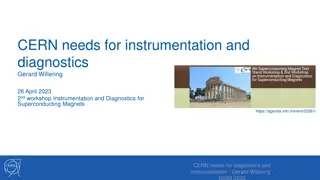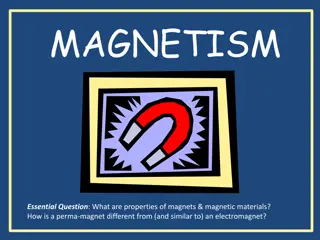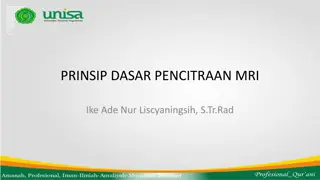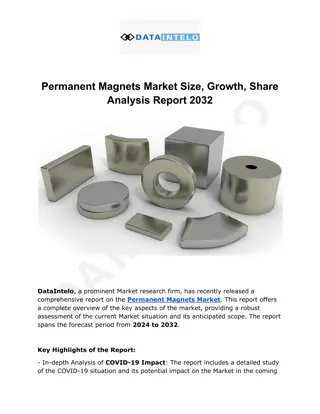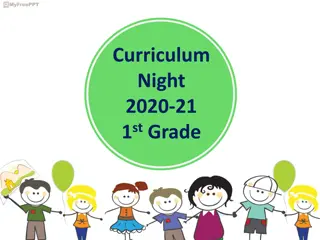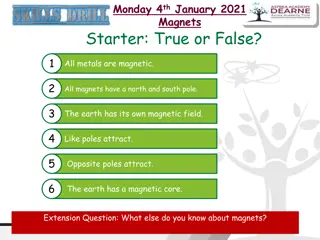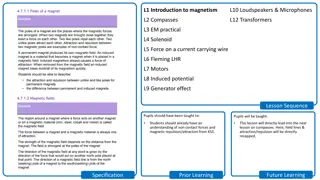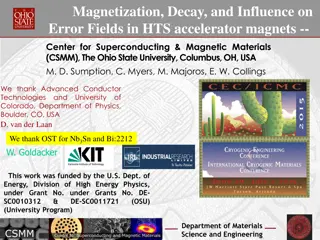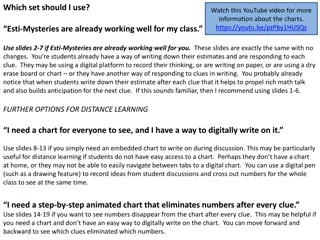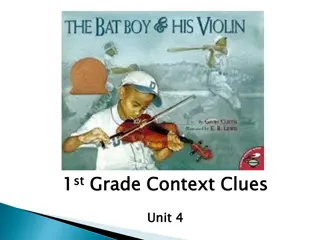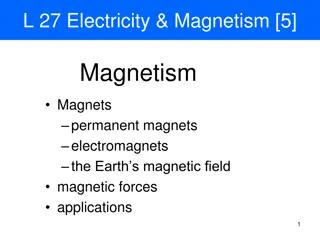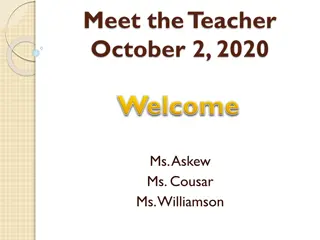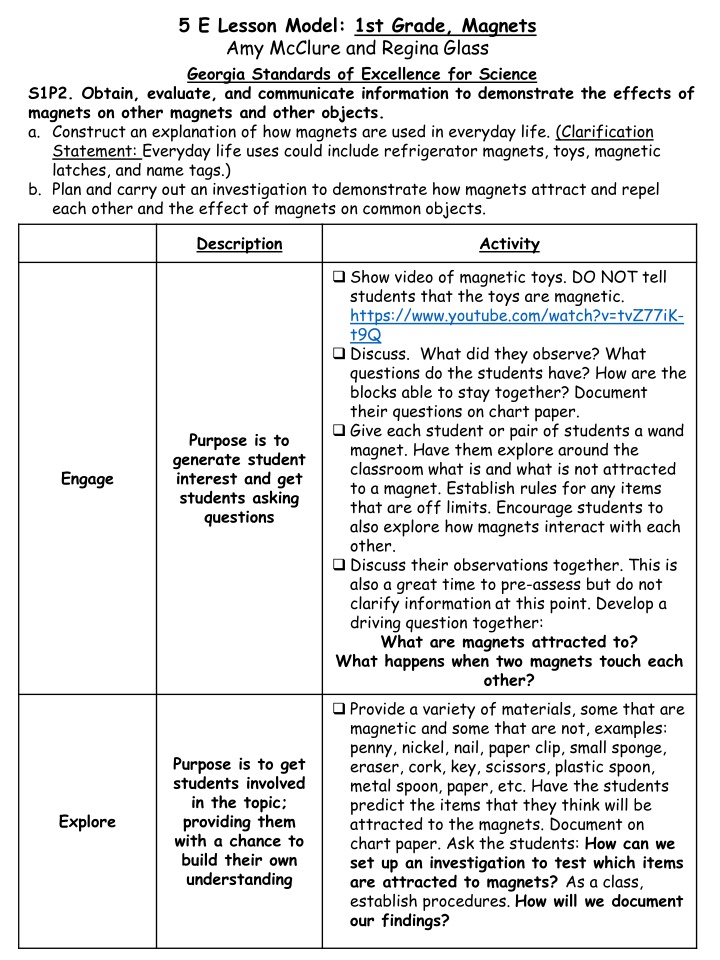
First Grade Magnets Lesson Activities
Engage first-grade students in hands-on investigations and discussion about magnets' effects on various objects. Explore magnetism through interactive activities, discussions, and STEM challenges to enhance understanding of how magnets work in everyday life.
Download Presentation

Please find below an Image/Link to download the presentation.
The content on the website is provided AS IS for your information and personal use only. It may not be sold, licensed, or shared on other websites without obtaining consent from the author. If you encounter any issues during the download, it is possible that the publisher has removed the file from their server.
You are allowed to download the files provided on this website for personal or commercial use, subject to the condition that they are used lawfully. All files are the property of their respective owners.
The content on the website is provided AS IS for your information and personal use only. It may not be sold, licensed, or shared on other websites without obtaining consent from the author.
E N D
Presentation Transcript
5 E Lesson Model: 1st Grade, Magnets Amy McClure and Regina Glass Georgia Standards of Excellence for Science S1P2. Obtain, evaluate, and communicate information to demonstrate the effects of magnets on other magnets and other objects. a. Construct an explanation of how magnets are used in everyday life. (Clarification Statement: Everyday life uses could include refrigerator magnets, toys, magnetic latches, and name tags.) b. Plan and carry out an investigation to demonstrate how magnets attract and repel each other and the effect of magnets on common objects. Description Activity Show video of magnetic toys. DO NOT tell students that the toys are magnetic. https://www.youtube.com/watch?v=tvZ77iK- t9Q Discuss. What did they observe? What questions do the students have? How are the blocks able to stay together? Document their questions on chart paper. Give each student or pair of students a wand magnet. Have them explore around the classroom what is and what is not attracted to a magnet. Establish rules for any items that are off limits. Encourage students to also explore how magnets interact with each other. Discuss their observations together. This is also a great time to pre-assess but do not clarify information at this point. Develop a driving question together: What are magnets attracted to? What happens when two magnets touch each other? Provide a variety of materials, some that are magnetic and some that are not, examples: penny, nickel, nail, paper clip, small sponge, eraser, cork, key, scissors, plastic spoon, metal spoon, paper, etc. Have the students predict the items that they think will be attracted to the magnets. Document on chart paper. Ask the students: How can we set up an investigation to test which items are attracted to magnets? As a class, establish procedures. How will we document our findings? Purpose is to generate student interest and get students asking questions Engage Purpose is to get students involved in the topic; providing them with a chance to build their own understanding Explore
Description Activity Following the investigation. have a science talk about what is attracted and what is not attracted to magnets. Use the CER writing framework to guide their writing on chart paper. Have several students share their ideas. Claim: Answer the questions. Examples: The paper clip is attracted to the magnet. The sponge is not attracted to the magnet. Evidence: Scientific data that support their claim. Examples: The paper clip stuck to the magnet when it got close. The sponge did not move when the magnet got closer. Have students then sort the items that were attracted and were not attracted to the magnets. What do they observe? What material were the items that were attracted to magnets made of? How would you describe the items that were attracted to magnets? What new questions do they have? Possible examples: Are all materials that are plastic not attracted to magnets? Are all metals attracted to magnets? Assist students in setting up an investigation that answers their new questions. Following their investigation, what new claims can they make. **Make sure to clarify that NOT ALL metals are attracted to magnets. Purpose is to provide students with an opportunity to communicate what they have learned so far and figure out what it means Explain Follow up with reading passages, Brainpopjr video on magnets, Epic! Readers on magnets, trade books, this video: https://www.youtube.com/watch?v=s236Q1nu WXg etc. to help them further understand their learning.
Description Activity STEM Challenge: The following scenarios can be introduced to the students for the STEM challenge. They can solve each problem by using a magnet. You can give each group of 3 students a different challenge or pick one challenge to assign to each group: Mrs. North s nametag is annoying her. It keeps poking her and coming undone. It also leaves a hole in her clothes when she uses it. Can you design and build a prototype of a new nametag that she can use? Mrs. South s bedroom window has a curtain. In the mornings, Mrs. South likes to let some sunshine in to warm up her room. She doesn t know how to keep her curtain from staying open without her having to hold it. Can you design and build a prototype of a device that will keep her curtain open in the mornings? Maggie s school binder will not stayed closed. When she puts it in her bookbag, all of her items come out of her binder. Can you design a way to keep her binder closed? Maggie s mom likes to keep her artwork on the refrigerator. She is out of tape and does not want to buy anymore. Can you design a device to keep her artwork on the refrigerator? Mrs. North s desk is very messy. She has spilled paper clips and rubber bands all in her drawer. She wants to organize her desk, but she thinks that it will take a long time to clean it up. Can you design a device to clean up the rubber bands and paper clips? Purpose is to allow students to apply their new knowledge and sills to a new situation Extend, Elaborate Provide appropriate materials for the different scenarios as well as materials for the different scenarios for students to test their designs. Students will write an explanation of how a magnet solved their problem.
Description Activity Use the engineering and design process to guide through the challenge: 1. Ask 2. Imagine 3. Plan 4. Create 5. Test/improve 6. Present Teacher observation and interaction during explore and explain Purpose is to allow students to apply their new knowledge and sills to a new situation Extend, Elaborate Purpose is to assess understanding through self, peer, or teacher observations Evaluate Presentation from STEM challenge Teacher created sort, etc. **This is a multi day lesson. Begin each day with the driving question. **Note that his lesson does not address an investigation to explore how magnets interact with each other.


